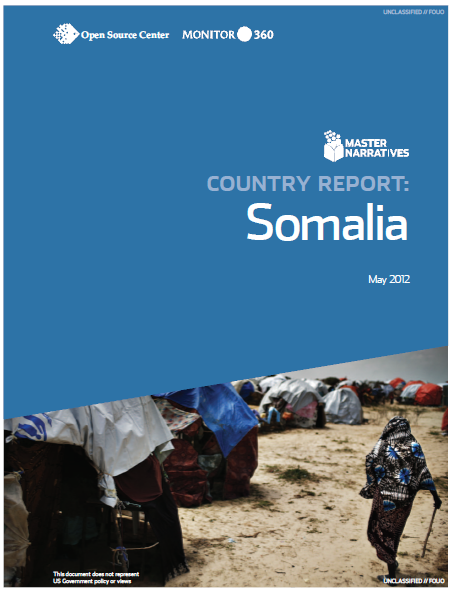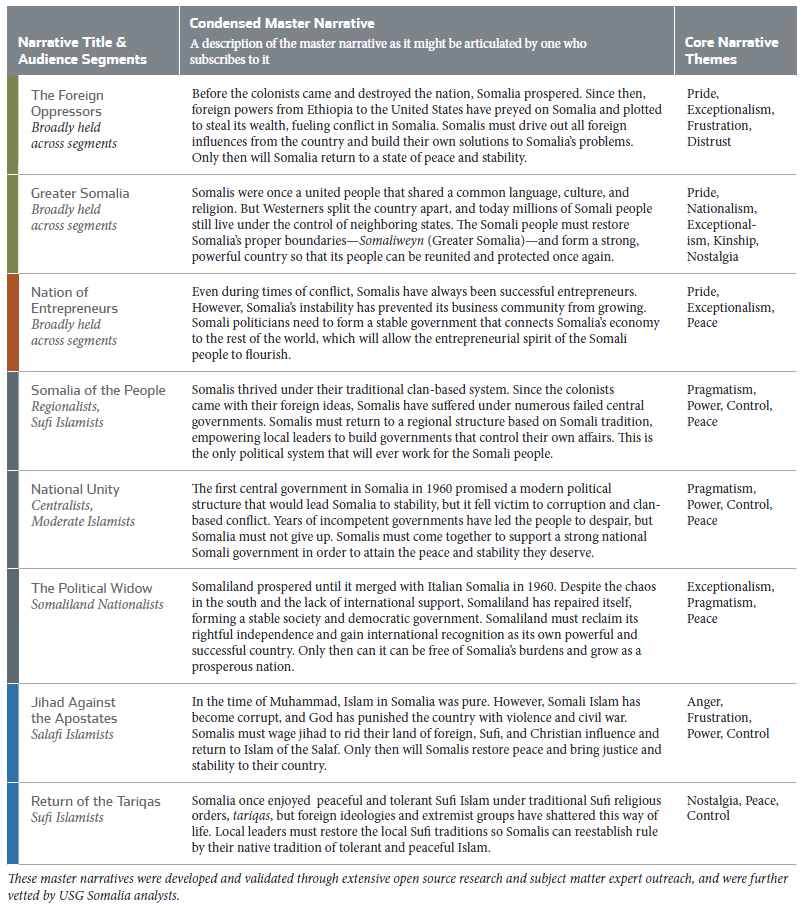The following document was originally published on Scribd by the Editor of the Grendel Report.
Master Narratives Country Report Somalia
- 64 pages
- For Official Use Only
- May 2012
- 2.96 MB
Understanding master narratives can be the difference between analytic anticipation and unwanted surprise, as well as the difference between communications successes and messaging gaffes. Master narratives are the historically grounded stories that reflect a community’s identity and experiences, or explain its hopes, aspirations, and concerns. These narratives help groups understand who they are and where they come from, and how to make sense of unfolding developments around them. As they do in all countries, effective communicators in Somalia invoke master narratives in order to move audiences in a preferred direction. Somali influencers rely on their native familiarity with these master narratives to use them effectively. This task is considerably more challenging for US communicators and analysts because they must place themselves in the mindset of foreign audiences who believe stories that — from an American vantage point — may appear surprising, conspiratorial, or even outlandish.
This report serves as a resource for addressing this challenge in two ways. First, it surfaces a set of eight master narratives carefully selected based on their potency in the Somali context and relevance to US strategic interests. Second, this report follows a consistent structure for articulating these narratives and explicitly identifies initial implications for US communicators and analysts. The set outlined here is not exhaustive: these eight master narratives represent a first step that communicators and analysts can efficiently apply to the specific messaging need or analytic question at hand. For seasoned Somali experts, these narratives will already be familiar — the content contained in this report can be used to help check assumptions, surface tacit knowledge, and aid customer communications. For newcomers to Somalia accounts, these narratives offer deep insights into the stories and perceptions that shape the Somali political context that may otherwise take years to accumulate.
Some master narratives cut across broad stretches of the Somali populace, while others are held only by particular audience segments. This study divides Somalia into six audience segments that demonstrate how different master narratives resonate with different sections of the populace. Each of the eight master narratives aligns with one or more of the following segments: Centralists, Regionalists, Somaliland Nationalists, Salafi Islamists, Sufi Islamists, and Moderate Islamists. (See the Appendix for a detailed description of these audience segments.) This audience segmentation is tailored specifically to surface important Somali master narratives and the interactions between them. Somali society is heavily influenced by longstanding clan structures, with some clan affiliations creating intractable intergroup conflict while other affiliations are more fluid in response to shifting political priorities. Some of the master narratives profiled in this report are deeply informed by clan dynamics, while others transcend clan allegiances altogether. Based on this, the audience segmentation is this report provides an additional lens for understanding competing and interconnected camps in Somali politics and society.
…


